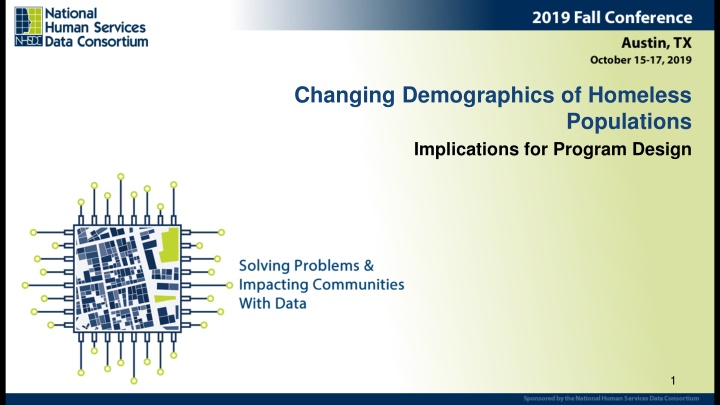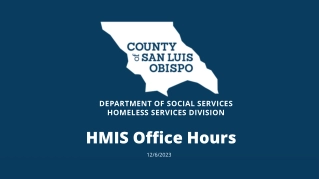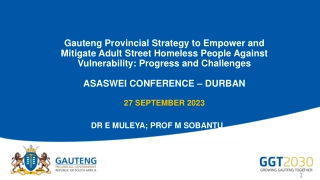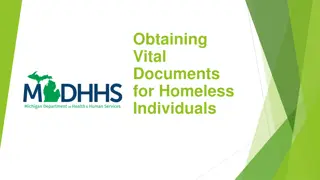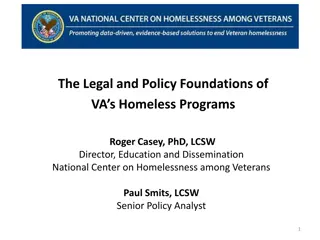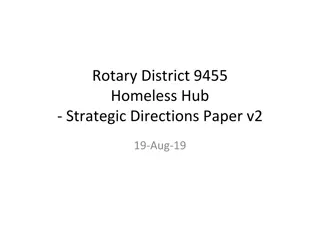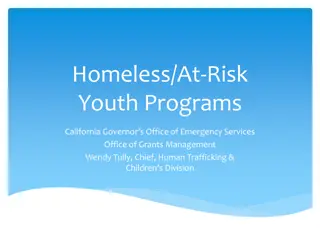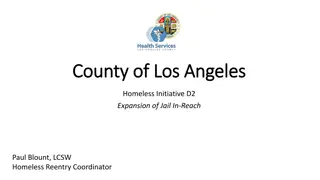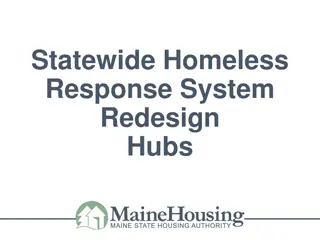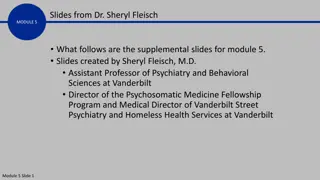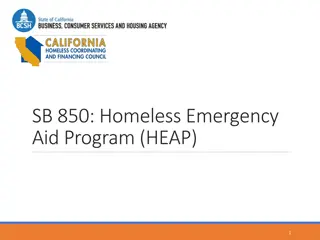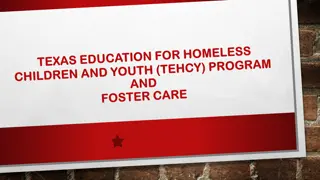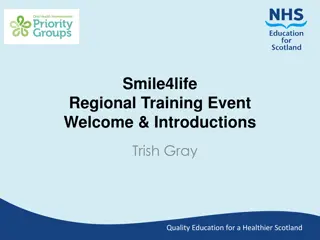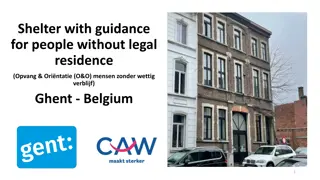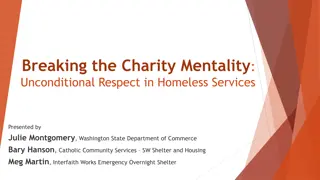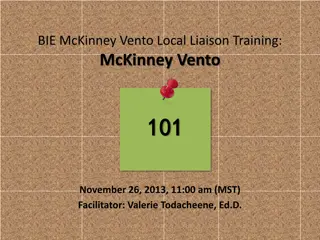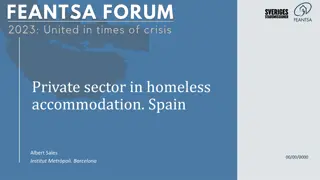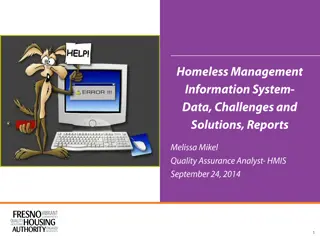Changing Demographics of Homeless Populations: Implications for Program Design
Using data to inform program design change by drawing inferences with trend and population data, including population disparity checks. Explore available demographic data in federal reports and a study on aged homelessness, along with new tools to identify trends and disparities.
Download Presentation

Please find below an Image/Link to download the presentation.
The content on the website is provided AS IS for your information and personal use only. It may not be sold, licensed, or shared on other websites without obtaining consent from the author.If you encounter any issues during the download, it is possible that the publisher has removed the file from their server.
You are allowed to download the files provided on this website for personal or commercial use, subject to the condition that they are used lawfully. All files are the property of their respective owners.
The content on the website is provided AS IS for your information and personal use only. It may not be sold, licensed, or shared on other websites without obtaining consent from the author.
E N D
Presentation Transcript
Changing Demographics of Homeless Populations Implications for Program Design 1
Session Focus Using data to inform Program Design change Learn how to draw inferences with trend and population data Include population disparity checks Learn about what types of population and trend data are available in two federal reports and a study on aged homelessness Examine new tools that you can use to identify demographic trends, disparities, and data meaningfulness 2
Overview 1. Comparisons: Homeless Veteran demographic data from the AHAR & SSVF Annual Report 2. National homelessness trends AHAR and the SSVF Annual Report Culhane s Report on Aged Homelessness 3. Implications for Program Design Using SSVF RRH as an example 4. Tools: Identify demographic trends, disparities, and develop context 3
National homelessness trends: AHAR & the SSVF Annual Report
Homelessness Demographics: AHAR and SSVF Annual Report AHAR Reports Part 1: PIT Count Data Part 2: HMIS Data (ES, TH project types) SSVF Annual Report 12 months of HMIS Data RRH & HP project types
Homelessness Demographics: AHAR and SSVF Annual Report Reports Comparison: Sheltered Veterans (2017 AHAR Part 2) to RRH Veterans (FY 2017 SSVF Annual Report) Demographic Comparisons: Household Type Gender Race/Ethnicity Age Disability 2019 Federal Permanent Housing Conference
Homelessness Demographics: AHAR and SSVF Annual Report (cont.) Household Type: Households w/children 12.2% FY 2017 SSVF 2017 Sheltered Homeless Veterans (Annualized) 2.7% Gender: Female 0% 5% 10% 15% 20% 25% 30% 35% 40% 45% 50% 13.6% FY 2017 SSVF 2017 Sheltered Homeless Veterans (Annualized) 8.1% 0% 5% 10% 15% 20% 25% 30% 35% 40% 45% 50%
Homelessness Demographics: AHAR and SSVF Annual Report (cont.) Race/Ethnicity* *For FY 2017, SSVF race/ethnicity data was only available for the combination of RRH and HP Veterans.
Homelessness Demographics: AHAR and SSVF Annual Report (cont.) Age Comparison Age Trend SSVF Rapid Re-housing Veterans Sheltered Veterans 19% 62+ 19% 39% 51-61 42% 33% Age 31-50 30% 8% 25-30 7% 1% 18-24 2% 0% 10% 20% 30% 40% 50%
Homelessness Demographics: AHAR and SSVF Annual Report (cont.) Disability Comparison Disability Trend SSVF Rapid Re-housing Veterans: Disability Sheltered Veterans: Disability 70% 62% FY 2017 SSVF 60% 50% 40% 30% 20% 10% 0% 2017 Sheltered Homeless Veterans (Annualized) FY 2015 FY 2016 FY 2017 FY 2018 59% 0% 20% 40% 60% 80% 100%
Homelessness Demographics: AHAR and SSVF Annual Report (cont.) Summary of 2017 Demographic Comparisons (proportional) HH type: Proportionally, SSVF RRH served 4.5 times more Veterans in HHs w/children than shelters Gender: Proportionally, SSVF RRH served 68% more Female Veterans than shelters Race/Ethnicity: SSVF and shelters served similar percentages of racial/ethnic groups; SSVF served a slightly higher percentage of racial/ethnic minorities Age SSVF RRH and shelters served Veterans of very similar ages The 62+ group has increased each year Disability Status SSVF RRH and shelters served Veterans of similar disability levels; slightly more for SSVF RRH in FY 2016 & 2017 The disability status group has increased each year
Homelessness Demographics: Culhane s research on aging homeless populations
The Emerging Crisis of Aged Homelessness Multi-site study including Boston, NYC, and Los Angeles County showing how the elderly homeless population is expected to triple over the next decade. Looks at: o Surge in related health care and shelter costs o Housing interventions that could help
The Emerging Crisis of Aged Homelessness (cont.) Contemporary homelessness is in large part a birth cohort phenomenon, disproportionately affecting people born in the latter half of the post- War baby boom (1955- 1965).
The Emerging Crisis of Aged Homelessness (cont.) The aged homeless population is growing rapidly and will continue to grow for the next decade.
The Emerging Crisis of Aged Homelessness (cont.) As aged homelessness grows, so too will service use and costs, including for hospital and nursing home stays. Subgroups among the aged homeless adult population can be segmented to reflect varying degrees of morbidity and intensity of shelter use. The four subgroups found in the study included older adults experiencing homelessness who had: 1. Moderate shelter use and moderate hospital & nursing home use (85%) 2. High shelter use and moderate hospital & nursing home use (11%) 3. Very high shelter use and moderate hospital & nursing home use (1%) 4. Low shelter use and high hospital & nursing home use (3%)
Study Citations Dennis P Culhane, Dan Treglia, Thomas Byrne, Stephen Metraux, et al. "The Emerging Crisis of Aged Homelessness: Could Housing Solutions Be Funded from Avoidance of Excess Shelter, Hospital and Nursing Home Costs?" (2019). Available at: http://works.bepress.com/dennis_culhane/223/ Meghan Henry, Korrin Bishop, Tanya de Sousa, Azim Shivji, and Rian Watt. The 2017 Annual Homeless Assessment Report (AHAR) to Congress - Part 2: Estimates of Homelessness in the United States (2018). Available at: https://www.hudexchange.info/resource/5769/2017-ahar-part-2-estimates-of-homelessness-in-the-us/ Mark Silverbush, John Kuhn, and Linda Southcott. SSVF Annual Report for FY 2017 (2018). Available at: https://www.va.gov/homeless/ssvf/docs/SSVF_FY2017_AnnualReport_508.pdf 17
Implications for Program Design Use demographic groups as a filter for analysis Focus on possible disparities and serving those with the most need Performance indicators to filter and compare Outcomes Permanent housing placements (Destination) Length of time Returns Average Cost per household
Performance indicators to filter and compare SSVF RRH: Permanent housing placements (Destination) n=43,690
Performance indicators to filter and compare SSVF RRH: Permanent housing placements (Destination) drill down by income at entry n=48,926
Performance indicators to filter and compare SSVF RRH (FY 2015-2017): Length of time n=103,041
Performance indicators to filter and compare SSVF: Returns to homelessness, 6 month view n= October 2011-September 2012: 32,033 Veterans; October 2014-September 2015: 53,388 Veterans; September 2016-August 2017: 38,370 SOURCES: SSVF-HMIS Repository data; HOMES.
SSVF Program Design Responses Improve the target of limited resources (such as TFA, VASH) Encourage planning and coordination with CoCs/Coordinated Entry Systems/VA Programs Combat challenges with innovation Rapid resolution/Problem solving Returning Home Shallow subsidy
SSVF Program Design Responses Improve the target of limited resources (such as TFA, VASH) Encourage planning and coordination with CoCs/Coordinated Entry Systems/VA Programs Combat challenges with innovation Rapid resolution/Problem solving Returning Home Shallow subsidy
SSVF Program Design Responses Use data to identify new partners for training and coordination, such as: SOAR Initiative (SSI/SSDI enrollment) Shared housing Landlord partnership development and maintenance Credit counseling and repair assistance Employment services program integration and referrals Services for older Veterans through the VA and in the community
Racial disparities within homeless populations and tools to analyze & address local bias
Racial disparities within homeless populations Previous discussion of AHAR and SSVF data demonstrated racial disparities within homeless populations at a national level CoCs can pair their Census data with PIT Count population data to gauge this at a more local level
Metrics to Analyze Racial Disparities in the Homeless Services System 1. Access to services, shelter and housing 2. Length of time people spend homeless and in the service system 3. Exit rates to permanent housing destinations 4. Returns to homelessness
Racial disparities within homeless populations (cont.) There are several tools available to help CoCs analyze racial disparities within their local homeless services system, including: CoC Analysis Tool: Race and Ethnicity (HUD) Available on the HUD Exchange website Select CoC; display charts and graphs related to local racial and ethnic breakdowns with comparisons to other geographies Stella Performance (HUD) - located within HDX 2.0 CoCs can use LSA data to take a deeper dive in their racial and ethnic analysis for different household types and population groups by: 1. The length of time people spend homeless and in the service system, 2. Successfully exiting homelessness to permanent housing, and 3. The degree to which households that are housed then fall back into homelessness.
Racial disparities within homeless populations (cont.) At the local level, communities are using additional strategies to address racial disparities: Philadelphia has used GIS to better understand the issue Syracuse participated in a workshop with Supporting Partnerships for Anti-Racist Communities (SPARC) to help think through the issue Los Angeles created an Ad Hoc Committee on Black People Experiencing Homelessness and published a study on Black People Experiencing Homelessness Others are being more conscious of ensuring the inclusion of people with lived experience in planning efforts, as well as reviewing diversity among project management staff
Tool Locations CoC Analysis Tool: Race and Ethnicity On the HUD Exchange: https://www.hudexchange.info/resource/5787/coc- analysis-tool-race-and-ethnicity/ Includes community discussion questions in the tool explainer Stella Performance (Stella P) On the HUD Homelessness Data Exchange (HDX) 2.0: https://hudhdx2.info 32
Mark Silverbush | Associate Abt Associates Mark_Silverbush@abtassoc.com Mary Schwartz | Associate Abt Associates Mary_Schwartz@abtassoc.com 33
